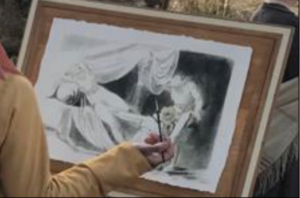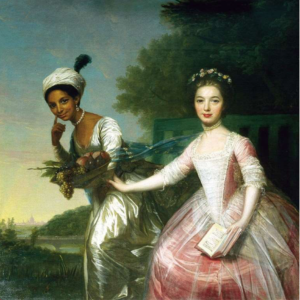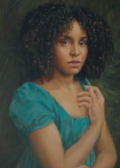In the Eye of the Beholder: Georgiana and her Portrait
By Elsa Kienberger
If season two of Sanditon showed us anything, it is that the eyes are easily deceived. After a season full of emotional manipulation through gaslighting and rakes disguised as men of gentility, the final episode retained a few surprises, including the revelation that Charles Lockhart (Alexander Vlahos) himself was the heinous family relation after Georgiana’s inheritance. Although intended to shock, Charles’s spurious character was present in early episodes, and not just through the ton’s discomfort with his eccentricity. His applications to paint Georgiana (Crystal Clarke) seem altruistic, yet they display an underlying misogynoir that limits her self-expression. In the context of Sanditon’s historical fiction, Georgiana’s power over the portrayal of her image resonates with modern expressions of beauty and even ongoing legislation about hairstyles. While Lockhart’s painting depicts one version of the heiress, when given the choice to determine how she should be represented, Georgiana directs Lockhart to an entirely different version of herself.
As viewers witnessed in the first season, Georgiana is an artist first and foremost before she becomes Charles’s muse. During a sketching session by the seaside with Charlotte in Season 1, Episode 3, she depicts something so obscene that not only must Sidney (Theo James) postpone a trip to reprimand her, but PBS also chose to edit it out of the episode. Crystal Clarke shared the drawing, which depicts a blurry ménage à trois, to her Twitter afterwards (her tweet is no longer available except as a reference in her interview with The Pemberley Podcast). This exemplifies Georgiana’s humor and strong perspective, and it also shows how she is often censored. In Regency society, it is easier for her to be a muse than to be a creator. Meanwhile, it is socially acceptable for Charles to have her sit for hours while he fastidiously studies her form, even without the presence of a chaperone.

To be clear, it is not the act of painting Georgiana that is concerning. The portrait itself contradicts white European renderings of Black people in the early nineteenth century. In persuading Georgiana to have Charles paint her, Arthur Parker (Turlough Convery) says that an artist “sees things with a rare clarity” and claims that Lockhart takes an unprejudiced approach to his work (S2E3). He then opens up to her about how personally meaningful a portrait Charles made of him had been because it conveyed a power he had always wanted others to see in himself. Knowing that he and Georgiana are bonded through a shared sense of feeling othered by their community, Arthur wants to share the profound experience of belonging with her. But even as Arthur struggles with social norms by being at odds with Regency masculinity, as a white Englishman he is able to mask his otherness. Meanwhile, Georgiana, the mixed-race daughter of an enslaved Black woman and a white slave owner, cannot pass as white. Charles proceeds to persuade her to be painted, saying “maybe you could tell me how you’d like to be seen” and wins her consent with the following stipulation: “You will paint my portrait on my terms” (S2E3). The underlying historical reality being that most Black women living in Regency England did not have control over their depictions.
In eighteenth-century Europe and the Americas it would have been common enough to see engravings of Black people who had escaped slavery and written about their experiences, such as Olaudah Equiano, and, later in the nineteenth century, to see photographs of Frederick Douglass, Ellen and William Craft, and Harriet Jacobs, to name a few. Most commonly, Black people appeared in the background of portraits by white artists as exotic subjects. A notable exception being Josiah Wedgwood’s “Am I not a man and a brother” emblem first appearing in 1787 for use in the abolitionist movement.
Black agency was rarely conveyed in European portraiture. Georgiana’s portrait is meant to rewrite, or rather, repaint this history, and the portrait itself is likely conversant with one of Georgiana’s real-life historical contemporaries, Dido Elizabeth Belle. Belle was the daughter of Maria Bell [sic], an African woman and Sir John Lindsay, a white Royal Naval officer. Her mother, Maria was an enslaved woman who paid for her own freedom in 1774, and while it is not known exactly when Dido came to England, it was around this time that she was entrusted to her father’s uncle. This man was William Murray, more famously known both historically and in Austen-lore as the First Earl of Mansfield and Lord Chief Justice, whose rulings aided the British abolition movement. In David Martin’s 1776 portrait of Belle alongside her cousin Lady Elizabeth Murray, Belle cannot escape Martin’s exoticizing brush, which swoops in to flourish her with tropical fruit. In Sanditon, viewers see fruit serving a political significance as well, with pineapples being used in connection with Georgiana’s goal to rally community support for abolition in both seasons of the series. Taking these details into consideration, the Martin’s foregrounding of a white woman and a Black woman together as equal companions is even more significant.

In Sanditon the issue of Georgiana’s portrait lies in how Charles frames his desire to paint her. Despite the “freedom” the portrait is supposed to grant her, it is problematic in the first place for a white man to be the benefactor of her self-realization, and additionally, his specific diction speaks to captivity and exploitative aesthetic consumption. Before gaining Georgiana’s consent for a portrait, he sketches her without it. The following argument ensues when she confronts him:
GEORGIANA: It was an act of gross presumption to do so without my permission. CHARLES: Do I need permission to admire you, Miss Lambe. And if you’re so grievously offended then why are you here?” (S2E3)
Charles’s response purposefully evades Georgiana’s point. Admiration is one thing but sketching a study of a person’s face without permission is another thing entirely—similar to taking a picture of someone without their consent today. By reproducing an image of her, he creates a piece of property, with ownership contingencies, that she did not want created in the first place. He also belittles her anger, by interpreting her visit in a way that is self-serving. Additionally, when he finishes the portrait and invites Georgiana to view it, he says “Well, Miss Lambe, have I captured you?” [emphasis mine], to which Georgiana responds with “Utterly”. Perhaps romantic on a surface level, the word “capture” juts out in a deeply unsettling way. As the late, influential bell hooks writes in Feminism is for Everybody: Passionate Politics: “[l]ove in patriarchal culture was linked to notions of possession, to paradigms of domination and submission wherein it was assumed one person would give love and another person receive it” (101). Charles sets up this dichotomy through painting Georgiana: he possesses and appropriates her image, dominates the expression of her form, and not only receives her love, but attempts to take her fortune. His last name “Lockhart” is also synonymous with “lock heart”, as if he could chain love or love’s pretense. The implications of Charles, as a white man, capturing Georgiana, a Black woman, by making her into a kind of property is unnerving. A viewer may accept Charles’s language as romantic in a patriarchal society where “ownership” and “possession” are considered legitimate expressions of affection. But at its core, it is not a love that can offer her the freedom she so desires and that viewers desire for her as well. In the season two finale, Georgiana discovers not only that Charles is no more than a con-artist, but also that she has been the designer of her freedom all along.
While she cannot control the perceptions of others, she does control how she expresses herself, and her hairstyle choices are significant examples of this. Throughout seasons one and two, Georgiana styles her hair in updos similar to the white British women around her. In a pivotal scene in episode five, Georgiana watches herself in a mirror as she holds her hair up, imitating her usual hairstyle, and then releases it, letting it fall in tight curls around her. This is how she later appears for her portrait session with Charles, prompting an exchange about kinds of inheritances:
GEORGIANA: You asked me how I wished to be seen. This is the hair my mother gave me.
CHARLES: What did your father give you?
GEORGIANA: Education, an inheritance. ‘Tis both a blessing and a curse. (S2E5)
After a little more dialogue in which Charles shares some of his background story, the scene ends in a passionate kiss between them, almost disguising the fact that as the camera pulls out, viewers can see pentimento in the portrait. Pentimento is when a previous painting choice can be seen beneath a new one, and in this scene it enables the audience to see Georgiana’s painted updo and freshly painted natural curls at the same time. In this way, the portrait becomes a symbol representing both sides of Georgiana’s familial and cultural African and European backgrounds. This is a deeply personal context in the midst of an intimate scene, and it is at the same time a political statement. A little over a week after the April 17th episode aired, The New York Times published the article “In Films and on TV, a New Openness to Natural Black Hairstyles”, which while it does not cite Sanditon specifically, does chart an overall rise in depicting and celebrating Afro-textured hair in cinematography after decades of discrimination in Hollywood and mainstream media. In fact, this Sanditon episode arrived not quite a month after the US House of Representatives passed the CROWN Act (Creating a Respectful and Open World for Natural Hair Act) for the second time. Although the Senate has yet to pass it, the move would finally make discrimination based on hairstyle and texture illegal at the federal level.
By having a nineteenth-century character make this hairstyle choice, Sanditon shows how Georgiana’s experiences as a mixed-race woman living in Regency England still resound in modern times. Georgiana’s self-expression is far more than her hairstyle choices, more than her relationships with artists and to art. As Georgiana continuously proves over the course of the two seasons, and doubtless will in future ones, she is her own muse, creating the future she desires.
Works Cited
hooks, bell. Feminism is for Everybody: Passionate Politics. Cambridge, MA: South End Press, 2000.
Sanditon. PBS Masterpiece, 2022. <https://www.congress.gov/bill/117th-congress/house-bill/2116/text>
Works Referenced
Barrett, Lindsey. “‘Am I Not a Man and a Brother?’: The Political Power of the Image”. TheBlack Atlantic. Duke University: 10 Feb. 2014. <https://sites.duke.edu/blackatlantic/2014/02/10/am-i-not-a-man-and-a-brother-the-political-power-of-the-image/>
“Episode One-hundred fifty: An Interview with Crystal Clarke of ‘Sanditon’”. The Pemberley Podcast. Hosted by Jillian Davis and Yolanda Rodriguez. 7 April 2020. <https://thepemberleypodcast.wordpress.com/2020/04/07/episode-one-hundred-fifty-an-interview-with-crystal-clarke-of-sanditon/>
H.R.2116 —Creating a Respectful and Open World for Natural Hair Act of 2022. 117th Congress. Referred in Senate 21 March 2022. <https://www.congress.gov/bill/117th-congress/house-bill/2116/text>
Martinbrough, Tiffany. “In Films and on TV, a New Openness to Natural Black Hairstyles”. The New York Times. 29 April 2022. <https://www.nytimes.com/2022/04/28/movies/natural-black-hairstyles-hollywood.html>




Social Media